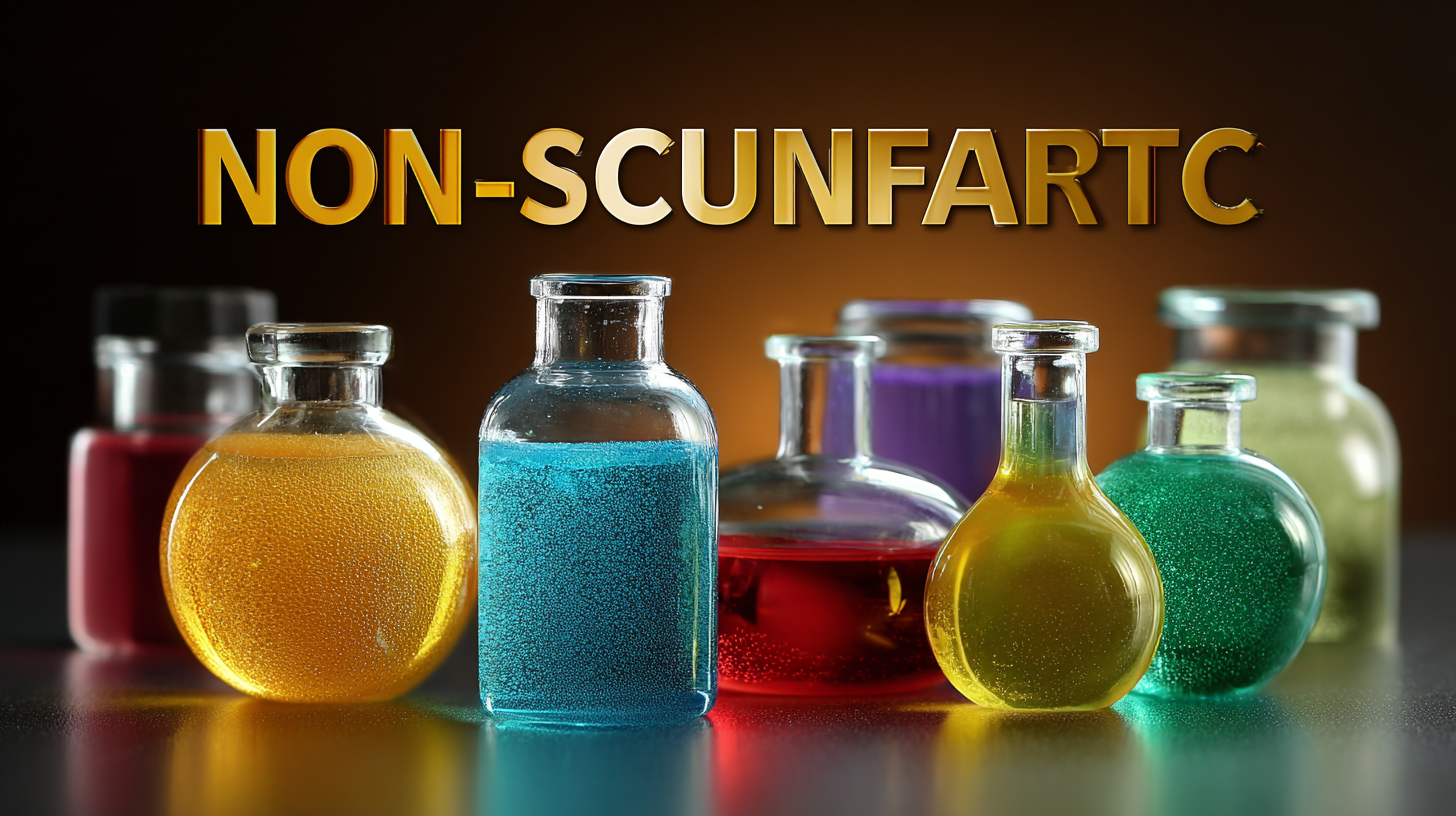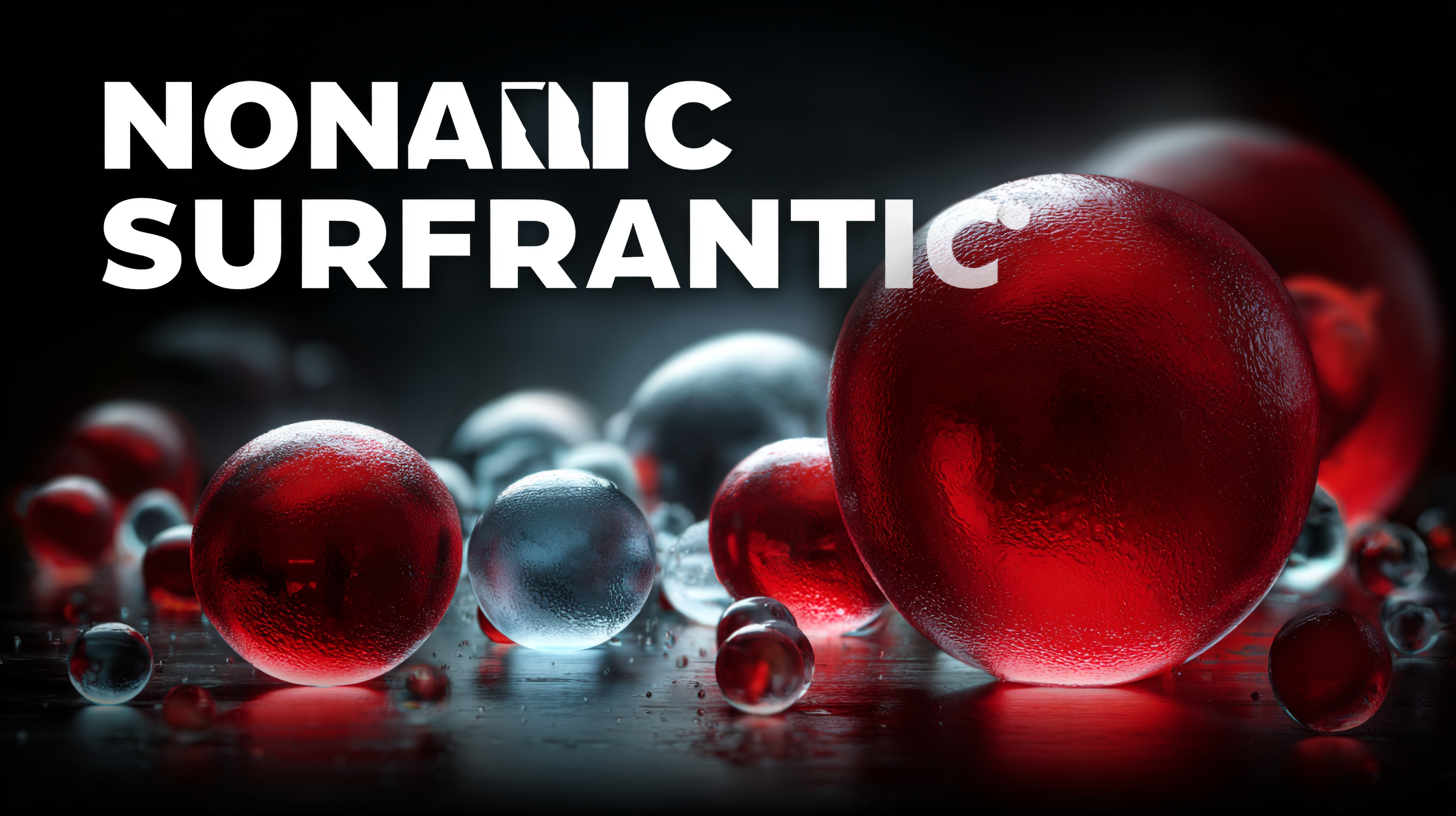
Top Strategies for Optimizing Best Nonionic Surfactant Performance in Industrial Applications
In today's industrial landscape, the efficient use of Nonionic Surfactants has become increasingly vital for achieving optimal performance across a range of applications. These versatile compounds play a crucial role in enhancing the effectiveness of formulations, improving product stability, and facilitating desired interactions between various components. As manufacturers strive to meet stringent performance and sustainability goals, understanding how to maximize the efficiency of Nonionic Surfactants becomes essential. This blog will explore top strategies and best practices that can be implemented to optimize the performance of Nonionic Surfactants in industrial settings. By delving into their properties, mechanisms of action, and methods for fine-tuning their application, we aim to equip industry professionals with the knowledge necessary to harness the full potential of these chemical agents, ultimately leading to enhanced operational efficiency and product performance.

Top Benefits of Nonionic Surfactants in Enhancing Industrial Process Efficiency
Nonionic surfactants play a pivotal role in enhancing industrial process efficiency across various applications. Unlike their ionic counterparts, nonionic surfactants are less sensitive to changes in pH and electrolyte concentration, making them ideal for a wide range of formulations. Their unique structure allows for excellent performance in emulsifying, wetting, and dispersing, which are crucial for optimizing operations in industries such as paint, agriculture, and textiles. By reducing surface tension, these surfactants improve the spreading and penetration of active ingredients, leading to more effective cleaning, foaming, and stabilization of products.
Moreover, nonionic surfactants contribute to sustainability in industrial processes. Their biodegradable nature reduces environmental impact, aligning with growing regulatory demands for greener production methods. Additionally, their compatibility with a variety of solvents enhances formulation flexibility, enabling manufacturers to achieve desired performance metrics without compromising safety or efficacy. This adaptability not only streamlines production but also enhances the overall quality of end products, resulting in increased customer satisfaction and loyalty. Through leveraging the advantages of nonionic surfactants, industries can drive efficiencies that ultimately lead to higher productivity and lower operational costs.
Top Strategies for Optimizing Best Nonionic Surfactant Performance in Industrial Applications - Top Benefits of Nonionic Surfactants in Enhancing Industrial Process Efficiency
| Application Area | Nonionic Surfactant Type | Benefit | Optimal Performance Strategy |
|---|---|---|---|
| Textile Industry | Ethoxylated Fatty Alcohols | Improved Wetting Properties | Optimize Concentration Levels |
| Agriculture | Glycerol Oleate | Enhanced Pesticide Efficiency | Adjust pH for Better Solubility |
| Food Industry | Sorbitan Esters | Improved Emulsification | Increase Mixing Time |
| Personal Care | Alkyl Polyglycosides | Mildness and Skin Compatibility | Formulate for Optimal Skin Feel |
| Cleaning Products | Nonylphenol Ethoxylates | Effective Soil Removal | Optimize Temperature During Use |
Key Performance Metrics for Evaluating Nonionic Surfactants in Various Industries
When evaluating nonionic surfactants in various industrial applications, it’s crucial to establish key performance metrics that truly reflect their efficacy. One of the primary metrics is the ability to reduce surface tension effectively. A lower surface tension enhances the wetting and spreading properties of the surfactant, making it essential in applications ranging from detergents to agrochemicals.
 Additionally, measuring the emulsification properties helps determine how well the surfactant can stabilize oil-water mixtures, which is vital in cosmetics and food industries.
Additionally, measuring the emulsification properties helps determine how well the surfactant can stabilize oil-water mixtures, which is vital in cosmetics and food industries.
Another important metric is the foaming capacity, which is particularly relevant in industries such as personal care and cleaning products. High foaming agents can improve user experience and product effectiveness. Moreover, stability and compatibility with various formulations should be assessed to ensure the surfactant functions effectively under different conditions. Lastly, toxicity and environmental impact metrics are increasingly becoming essential as regulations tighten around chemical safety. By systematically analyzing these key performance metrics, industries can optimize the use of nonionic surfactants for enhanced performance and sustainability.
Influence of Alkalinity and Temperature on Nonionic Surfactant Effectiveness
When exploring the effectiveness of nonionic surfactants in industrial applications, two critical factors to consider are
alkalinity and temperature.
Alkalinity can significantly influence the solubility and activity of nonionic surfactants. A higher pH environment can enhance
the surfactant's ability to interact with and emulsify various substances, leading to improved cleaning and dispersion properties.
However, optimal alkalinity levels must be carefully determined, as excessively high pH can also result in surfactant
degradation or reduced performance.
Temperature is another crucial variable impacting nonionic surfactant efficiency. Elevated temperatures often enhance surfactant
activity by increasing molecular motion, which can improve the rate of dispersion and the speed of emulsification processes.
Nevertheless, it is important to note that different nonionic surfactants may exhibit varying thermal stability. Therefore,
understanding the thermal threshold for specific surfactants is essential to maintain their efficacy. By carefully managing
both alkalinity and temperature, industries can optimize the performance of nonionic surfactants for a variety of applications,
from cleaning agents to coatings.
Innovative Formulations of Nonionic Surfactants for Specialty Applications
 Innovative formulations of nonionic surfactants have gained significant attention in specialty applications due to their versatility and efficacy. These surfactants, which do not carry a net electrical charge, make them ideal for sensitive applications such as personal care products, pharmaceuticals, and agriculture. Recent advancements in formulation strategies have allowed industries to enhance the performance and stability of nonionic surfactants, tailoring them to meet specific requirements. For instance, the incorporation of biodegradable components and performance enhancers not only optimizes their functionality but also adheres to growing environmental regulations.
Innovative formulations of nonionic surfactants have gained significant attention in specialty applications due to their versatility and efficacy. These surfactants, which do not carry a net electrical charge, make them ideal for sensitive applications such as personal care products, pharmaceuticals, and agriculture. Recent advancements in formulation strategies have allowed industries to enhance the performance and stability of nonionic surfactants, tailoring them to meet specific requirements. For instance, the incorporation of biodegradable components and performance enhancers not only optimizes their functionality but also adheres to growing environmental regulations.
One promising area of development is the creation of specialized blends that combine nonionic surfactants with other types of surfactants or additives. This synergistic approach can lead to improved dispersibility, wetting, and emulsifying properties, which are crucial in applications such as cleaning agents and industrial processes. Additionally, the use of novel materials such as bio-based oils and polymers in these formulations is paving the way for sustainable solutions that do not compromise on effectiveness. Ultimately, the focus on innovative formulations not only enhances the performance of nonionic surfactants but also positions them as essential components in the pursuit of eco-friendly industrial practices.
Comparative Analysis: Nonionic Surfactants vs. Other Surfactant Types in Industry
Nonionic surfactants are increasingly recognized for their unique advantages compared to other surfactant types, particularly in industrial applications. Unlike anionic and cationic surfactants, nonionic surfactants do not possess a charge, which renders them less sensitive to water hardness and more compatible with various formulations. This intrinsic property enhances their performance in difficult environments, making them essential in processes like electric discharge machining (EDM), where modified dielectrics combine nonionic liquids to boost efficiency.
When evaluating surfactants for specific applications, it is crucial to consider their environmental impact and sustainability. Recent developments highlight the rise of green surfactants, including biosurfactants, which offer a petroleum-free alternative that aligns with sustainability goals. Industries are increasingly shifting toward these eco-friendly options not only to mitigate environmental concerns but also to meet regulatory requirements.
Tips for Optimizing Nonionic Surfactant Performance:
- Compatibility Checks: Ensure that the selected nonionic surfactants are compatible with other components in your formulation to avoid unexpected interactions that could compromise performance.
- Application-Specific Formulation: Tailor the concentration and type of nonionic surfactant based on the particular industrial application to maximize efficiency and desired outcomes.
- Consider Eco-Friendly Alternatives: Explore the use of green surfactants in your production processes to enhance sustainability while maintaining performance standards.
